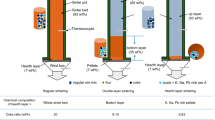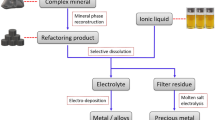Conclusions
Study of the phase composition and structure of chrome-magnesite refractories of different composition and degrees of firing led to the development of a range of practical proposals to improve the production technology.
The quality of chrome-magnesite refractories can be radically improved mainly by obtaining in them secondary magnesia spinels with energy-stable crystal lattices (mp. above 2100°C) and by getting a phase composition close to equi brium. In this case the intermediate mineral formations will change into stable highly refractory compounds.
With existing production methods for chrome-magnesite refractories such mineral-forming processes can be ensured only by using finely ground powders of chromite and magnesite in conjunction with high-temperature firing (of the order of 1750°C and higher).
To make high-grade roof and converter magnesite-chromite refractories, the most promising method is the production of periclase-spinel goods by the ordinary or briquette technology.
Technological measures for producing roof magnesite-chromite goods from coarsely ground chromite ores (3-0 mm fraction) are of no value, since during firing they develop nonequilibria phases with low melting points and secondary spinels of unstable structure possessing unsatisfactory properties compared with magnesia spinels used in the production of periclase-spinel goods.
To prepare high-grade roof and periclase-spinel magnesite-chromite refractories it is necessary to use enriched Kimpersai ores and magnesite powder with a minimum content of impurities, so as to ensure that the silicate bond of the finished goods will contain secondary spinels with a fusion temperature of above 2100°C instead of forsterite and montichellite with eutectic temperatures with spinel of 1670° and 1430° respectively.
Similar content being viewed by others
Literature cited
D. S. Belyankin, et al., Petrography of Technical Stones, Moscow, pub. Acad. Sci. USSR, 1952 [in Russian].
B. V. Ivanov, Questions of Petrography and Mineralogy, Pub. Acad. Sci. USSR II, 1953, p. 358.
A. S. Berezhnoi, Ogneupory 1953, No. 1.
L. F. Hyslop, Trans. Brit. Cer. Soc., 52, 534 (1953).
R. Trojer, Radex Rundschau, 1954, No. 6, 214.
R. Rigards, A. Gunn, and N. Dobbins, Trans. Brit. Cer. Soc, 1956, 55, 8.
V. V. Lapin, Physico-Technical Principles of Ceramics, Moscow, Promstroiizdat, 1956, p. 114.
R. Trojer, Radex Rundschau, 1959, 3/4, 123.
S. M. Zubakov and I. K. Balakh, Acad. Sci. KazSSR, No. 3 (1959), p. 109.
S. M. Zubakov, Mineral formation in chrome-magnesite refractories, Acad. Sci. KazSSR, (1960).
L. I. Karyakin, Album of macro- and micro-photographs of refractories and raw materials, Metallurgizdat, 1960, [in Russian].
L. I. Karyakin, Petrography of Refractories Metallurgizdat, 1962 [in Russian].
P. P. Budnikov, et al., Technology of Ceramics and Refractories, Moscow, Gosstroiizdat, 1962.
J. White, Iron a. Steel Inst., 1962, p. 8.
Author information
Authors and Affiliations
Rights and permissions
About this article
Cite this article
Zubakov, S.M., Yusupova, É.M. The phase composition of chrome-magnesite refractories. Refractories 5, 28–33 (1964). https://doi.org/10.1007/BF01290446
Issue Date:
DOI: https://doi.org/10.1007/BF01290446




